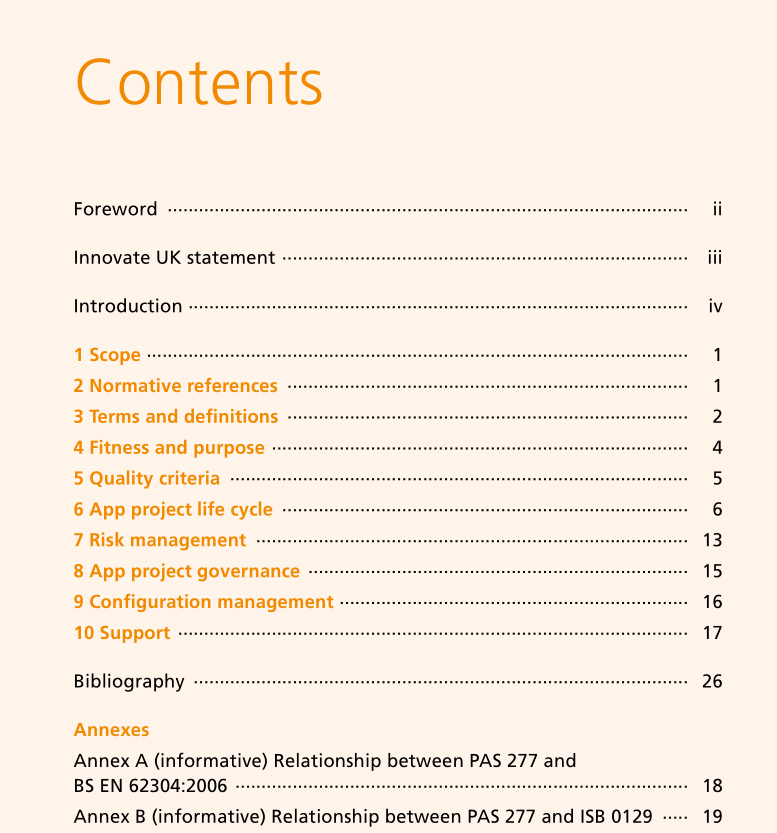PAS 277:2015 pdf download.Health and wellness apps – Quality criteria across the life cycle – Code of practice
1 Scope
This PAS gives recommendations for developers of health and wellness apps, intending to meet the needs of health care professionals, patients, carers and the wider public. It includes a set of quality criteria and covers the app project life cycle, through the development, testing, releasing and updating of an app, including native, hybrid and web based apps, those apps associated with wearable, ambient and other health equipment and apps that are linked to other apps. It also addresses ftness for purpose and the monitoring of usage. This PAS does not cover the processes or criteria that an app developer or publisher follow to establish whether a health and wellness app is subject to regulatory control (e.g. as a medical device, or related to information governance). This PAS informs the development of health and wellness apps irrespective of whether they are placed in the market, and including free of charge. NOTE 1 The development and placing on the market, including free of charge, of a health and wellness app may be covered by certain legislation, for example the Medical Devices Directive [1]. NOTE 2 The focus of this PAS is on commodity apps available through app repositories, but may also be relevant to specialized applications running on other platforms. NOTE 3 This PAS is not intended to replace documentation provided by platform curators on requirements for apps made available on the platform, unless referenced by platform curators. NOTE 4 It is not intended to cover apps for enforcement or legal advice purposes. For example, apps used to monitor alcohol levels for drivers are out of scope.
3 Terms and defnitions
For the purpose of this PAS the following terms and defnitions apply. 3.1 app 3.1.1 app software application that can be executed (run) on a computing platform, and is typically a small application run or accessed on mobile devices NOTE 1 Apps were initially established as a category of software developed to run on mobile platforms for a single or limited number of purposes. However, the distinction between apps and other software applications has become less clear as a wider range of computing platforms are marketed as supporting apps and app repositories, and as apps with a wider range of functions are developed. NOTE 2 An example is, a handheld commercial off-the- shelf computing platform, with or without wireless connectivity, or a web-based software application that is tailored to a mobile platform but is executed on a server. 3.1.2 health and wellness app app that contributes to any aspect of the physical, mental or social wellbeing of the user (3.20) or any other subject of care or wellbeing (3.19) {Adapted from WHO defnition of “health”[6]} 3.1.3 native app app that has been developed and distributed to run on a specifc platform, and as such may take advantage of application programming interfaces and functionality that is unique to that platform, and that can be distributed and updated via an app repository (3.8) associated with that platform 3.1.4 web based app website that is created to look and feel like a native app but that is accessed by web browser software (e.g. Chrome or Safari) running on a mobile device NOTE 1 The app developer makes the app available from a web server in a similar way to a regular website, as a link rather than an app repository. NOTE 2 Some native device functions (e.g. GPS, device motion) may still be available to the web-app via the web application programming interface (e.g. HTML5 or Javascript). 3.1.5 hybrid app app that is installed in the same way as a native app (3.1.3), but includes functionality that is delivered using an embedded browser from a web server NOTE Hybrid apps may be used to deliver richer functionality than web based apps by providing access to platform-specifc functionality, and may be distributed and updated using the app repository associated with that platform. 3.2 app developer individual or organization responsible for the development and maintenance of an app NOTE The app developer may also be the app publisher (3.6). 3.3 app project set of activities and tasks that comprise the app project life cycle (3.4) NOTE In practice an app project may be managed as activities and tasks within a series of separate projects. 3.4 app project life cycle follows the app from initial vision, through development and use, to fnal discontinuation of support NOTE 1 The app project life cycle is a framework for the tasks and activities that are undertaken by an app publisher. NOTE 2 Where the term is not qualifed it may be assumed to apply to both the product life cycle and project life cycle.
PAS 277:2015 pdf download
